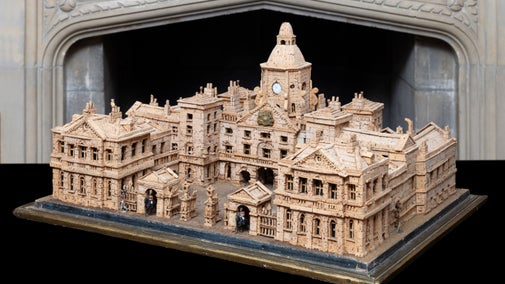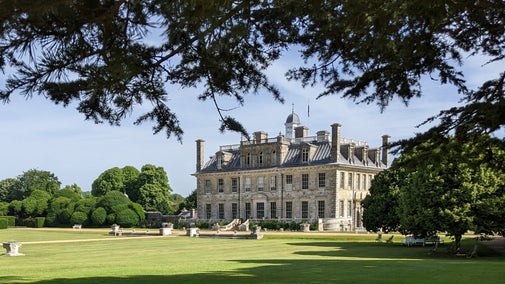
Kingston Lacy's collections
Explore the objects and works of art we care for at Kingston Lacy on the National Trust Collections website.

No fewer than seven of the artefacts housed at Kingston Lacy feature in the National Trust's book 125 Treasures. Discover more about some of the objects and paintings held in this astonishingly rich collection.
Standing outside on the South Lawn is the 9m-tall Philae Obelisk. Originally, it stood at the entrance to the Temple of Isis on Egypt’s sacred island of Philae. It was transferred to Kingston Lacy after William John Bankes encountered it on his Egyptian travels (1815–19). It took six years for the obelisk to journey from Philae to England, where it eventually arrived in 1821.
Bankes, the owner of Kingston Lacy, was highly educated and intellectually curious. It was these traits that led him to observe that the inscriptions on the obelisk were, in fact, in two different languages. He saw Ancient Egyptian hieroglyphs on the main shaft and Ancient Greek markings on the supporting plinth.
Bankes identified the names of Ptolemy and Cleopatra in hieroglyphic characters. These and other engravings on the obelisk went on to contribute towards the European decipherment of Egyptian hieroglyphs led by scholar Jean-François Champollion in 1822.
Kingston Lacy’s collection of Egyptian artefacts is the largest in private ownership in the UK. It also includes another obelisk, sarcophagi and many more artefacts that are displayed inside the house.

The cabinet will be undergoing restoration work in 2025, and will not be on display till 2026.
The cabinet was made in around 1760 in the east Indian port town of Visakhapatnam. The town was a centre for textile and furniture manufacture, and became well known for creating inlaid ivory work. The cabinet's extravagant design and intricate craftsmanship make it one of the finest examples of Visakhapatnam furniture in any English collection.
As is typical of Visakhapatnam pieces, the cabinet blends Dutch and English styles of furniture with Indian craftsmanship and materials. The stand has cabriole legs and lion’s paw feet, which are characteristic of Dutch furniture design of the 1740s and 1750s, while the top of the cabinet closely resembles English design of the 1760s.
The cabinet is decorated with a combination of ivory inlaid into rosewood and solid engraved ivory. The wooden panelled doors are inlaid with detailed representations of palm trees similar to designs used on Indian textiles at the time. The interior is highly decorated and features ivory columns and balustrades with drawers inlaid with flower, fruit and leaf designs.
It's possible that the cabinet came to Kingston Lacy through George Bankes, who was appointed to the select committee on the East India Company in 1831. India was then the centre of the British Empire, and its furniture was later promoted at international exhibitions such as the Great Exhibition in 1851.

Although it's not considered to be one of the most important works in the Kingston Lacy collection, Omnia Vanitas is very interesting. The painting has been the subject of recent extensive conservation and technical analysis. It was chosen for treatment following a suggestion by two scholars that it could be the work of Titian, who is regarded as the greatest painter of 16th-century Venice.
Omnia Vanitas is an allegorical painting (or story painting) depicting the vice of vanity. The oil on canvas shows a full-length female nude reclining on a couch, lightly draped, looking upwards at a painted plaque on which is written OMNIA VANITAS (All is Vanity). A crown and sceptre lie at her feet, while on the floor by her hands are money bags and a pile of gold coins.
William John Bankes acquired the painting in 1820 from the Marescalchi collection in Bologna. Originally, it hung in the Billiard Room at Kingston Lacy (now the State Bedroom). However, the 1856 inventory for the house shows that the painting had by then been transferred to the Saloon.
In 2017, the painting was transferred to the Hamilton Kerr Institute in Cambridge for cleaning, relining and extensive analysis. This included paint analysis, X-ray photography and infrared reflectography, a method that reveals under-drawings.
The latter revealed an exciting discovery: the presence of a female head to the side of the nude. It also exposed other aspects of an earlier composition. These included what appeared to be a mirror above the thigh, and possibly a hand behind the nude’s head.
Exposure to X-rays also confirmed the presence of a head to the right of the nude and the possible hand behind the head of the nude. X-ray analysis was particularly useful in this case, as it revealed areas where lead white (impenetrable by X-rays) had been used by the artist.
Paint analysis – used to reveal different layers of paint and to identify pigments – indicated that the pigments used by the artist were very similar to those used by Titian. This confirms that the painting is not a later copy.
The painting has been examined by a number of leading art historians. Current opinion is that it's probably not by Titian, but that it was definitely produced in his studio.
Scholars concluded that the compositional changes indicate that either Titian contributed to the composition, or that it remained unfinished at the time of his death, and so was completed by one of his assistants.

The Spanish Room (formerly the Golden Room) is arguably William John Bankes's greatest achievement. The room is also the most complete expression of his design intentions for Kingston Lacy. It can be read as a total work of art: a set piece comprising a gilded, coffered Venetian ceiling, painted leather wall panels, and a remarkable assemblage of Spanish paintings and decorative surfaces.
The room, which was created to display William John’s collection of Spanish paintings, epitomises his emphasis on creating an overall richness of effect in contrast to favouring individual works of art. Each and every element was consciously acquired and displayed with the whole in mind. In 1850, while exiled in Venice, William John wrote to his sister, Anne (Lady Falmouth), to enquire of newly completed decorative details, including the inscribed cartouches over the paintings. He asked: ‘Does it add to the richness of effect?'
Although William John was primarily concerned with creating a total effect, he collected individual works of art with a keen eye and a discerning judgement. Most of the Spanish paintings that decorate the walls were acquired during his service with the Duke of Wellington in the Spanish Peninsular War (c.1812-14). He consciously collected a representative selection of works by the great 17th-century Spanish artists, including Velázquez, Murillo and Cano. The only loss from the collection is Velázquez’s Philip IV of Spain, which was sold in the late 19th century by Walter Ralph Bankes.
The Spanish Room’s walls and ceiling are equally noteworthy, both for their individual significance and for adding to the overall effect of the room. Painted and tooled leather panels of scrolling foliage clad the walls. They're a mixture of old panels that William John acquired from Venetian palaces and new ones that he commissioned to match.
The ceiling was almost completed before William John was forced into voluntary exile in 1841. He purchased the ceiling paintings from a London art dealer in the belief that they came from the Palazzo Contrari degli Scrigni on the banks of the Grand Canal. However, only the grotesque panels of swirling foliage originated there. The three pictorial canvases, including The Creation of the Elements, were in fact copies of works by Paolo Veronese. Their value as copies is, however, significant, for the originals were destroyed in Berlin during the Second World War.
Also significant to the room are the pietra dura (a decorative art involving highly polished, coloured stones inlaid to create a picture) cabinet and the three double doors. Made from walnut frames, each is inset with four pearwood panels painted with designs representing the 12 months of the year. William John’s designs for the panels survive in the Bankes Archive (deposited with Dorset History Centre).

Explore the objects and works of art we care for at Kingston Lacy on the National Trust Collections website.
The art and heritage collections we care for rival the world’s greatest museums. Learn more about the collection of paintings, decorative art, costume, books, household and other objects at historic places.

See the breadth of our collection of works of art, furniture and more: we care for around a million objects at over 200 historic places, there’s a surprise discovery around every corner.

Discover the stories behind some of the greatest artworks and artefacts looked after by the National Trust, as told in a dedicated book, 125 Treasures from the Collections of the National Trust.

Find out more about the Bankes family home. Discover art treasures and look at how a large home was used by the family and their visitors who came to stay.

Relax and wander the gardens to enjoy seasonal interest at any time of year, with plenty of space for children to run, skip and play, and spaces to stop along the way.

A vision from Venice nestled in a pocket of Dorset. Read about Kingston Lacy’s most influential owner who made it the important place you see today.

Home Farm on the wider estate is home to the special Red Ruby Devon cows and rare breed Portland sheep. Find out why you’ll see them out on the Kingston Lacy estate.

Sample the delicious menu at the Stables Café or visit the National Trust shop to browse a wide range of gifts, souvenirs and local produce. There's also a second-hand book store stocking a huge selection of titles, old and new.
